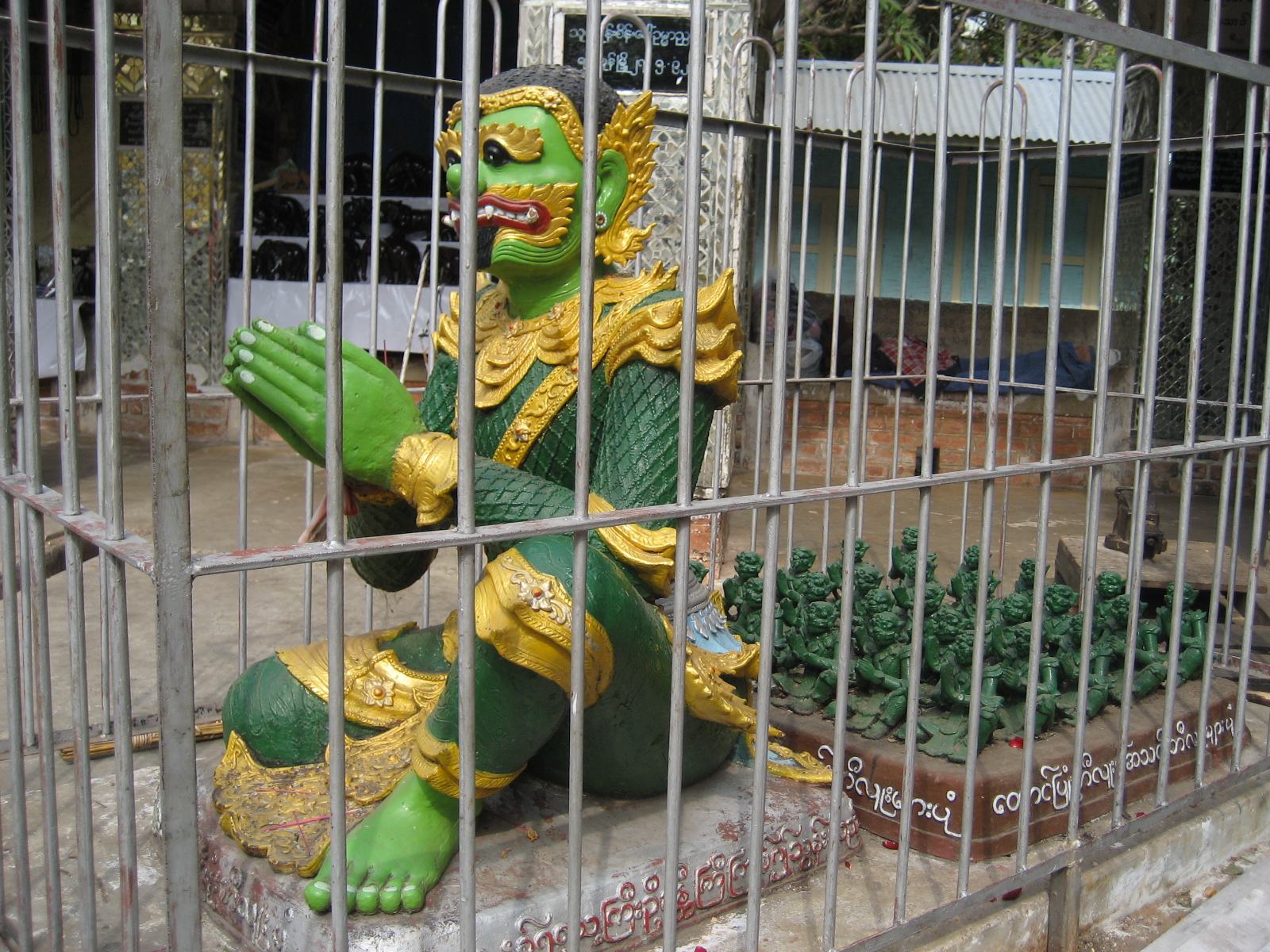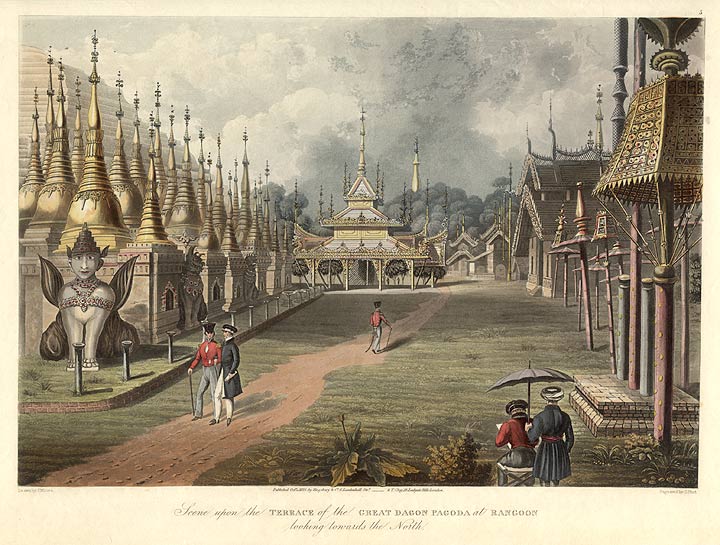|
Mandalay Hill
Mandalay Hill ( ) is a hill located to the northeast of the city centre of Mandalay in Myanmar. The city took its name from the hill. Mandalay Hill is known for its abundance of pagodas and monasteries, and has been a major pilgrimage site for Burmese Buddhists for nearly two centuries. At the top of the hill is the Sutaungpyei (literally wish-fulfilling) Pagoda. A panoramic view of Mandalay from the top of Mandalay Hill alone makes it worthwhile to attempt a climb up its stairways. There are four covered stairways called saungdan leading up the hill from the south, southeast, west and north, and convenient seats of masonry work line these stairways all the way up. A one-way motor road today saves time and also makes it accessible for those who are unable to climb up the stairs, leading to an escalator and a lift to the pagoda at the summit. Climbing Mandalay Hill Buddhists consider climbing the hill a rewarding experience and a meritorious deed for those able to do so. Two s ... [...More Info...] [...Related Items...] OR: [Wikipedia] [Google] [Baidu] |
List Of Mountains In Burma
The following is a list of mountains in Myanmar (Burma). The elevations are in metres. For the names of the mountains in the Latin script the most common transcription has been adopted. Note: Many mountains in the country are important not because of their height, but because of their symbolic and cultural significance. Some mountains have Buddhist worship places on top. Since the order of height is convenient, the list follows this order, without in any way intending to diminish or promote the importance of any particular mountain. List Above 5000 m * Hkakabo Razi, 5,881 m (Highest point in Myanmar and in Southeast Asia Countries) * Gamlang Razi, 5,870 m * Peak 5710, 5,710 mTamotsu NakamuraVeiled Mountains in North Myanmar Japanese Alpine News 2015 * Dindaw Razi, 5,464 m * Peak 5412 m,5,411 m * Peak 5310 m, 5,309 m * Peak 5224 m, 5,223 m * Peak 5219 m, 5,218 m * Peak 5188 m, 5,187 m * Peak 5127 m, 5,126 m * Peak 5127 m, 5,126 m * Peak 5111 m, 5,110 m * ... [...More Info...] [...Related Items...] OR: [Wikipedia] [Google] [Baidu] |
Konbaung Dynasty
The Konbaung dynasty (), also known as the Third Burmese Empire (တတိယမြန်မာနိုင်ငံတော်), was the last dynasty that ruled Burma from 1752 to 1885. It created the second-largest empire in history of Myanmar, Burmese history and continued the administrative reforms begun by the Toungoo dynasty, laying the foundations of the modern state of Burma. The reforms, however, proved insufficient to stem the advance of the British Empire, who defeated the Burmese in all three Anglo-Burmese Wars over a six-decade span (1824–1885) and ended the millennium-old Burmese monarchy in 1885. Pretenders to the dynasty claim descent from Myat Phaya Lat, one of Thibaw's daughters. An expansionist dynasty, the Konbaung kings waged campaigns against the Mizo Chieftainship, Lushai Hills, Möng Mao, Manipur, Assam, Kingdom of Mrauk U, Arakan, the Mon people, Mon kingdom of Restored Hanthawaddy Kingdom, Pegu, Siam, and the Qing dynasty of China—thus establis ... [...More Info...] [...Related Items...] OR: [Wikipedia] [Google] [Baidu] |
Kuthodaw Pagoda
Kuthodaw Pagoda (, ; , and formally titled Mahalawka Marazein ) is a Buddhist stupa, located in Mandalay, Burma (Myanmar), that contains the world's largest book. It lies at the foot of Mandalay Hill and was built during the reign of King Mindon. The stupa itself, which is gilded above its terraces, is high, and is modelled after the Shwezigon Pagoda at Nyaung-U near Bagan. In the grounds of the pagoda are 729 ''kyauksa gu'' or stone-inscription caves, each containing a marble slab inscribed on both sides with a page of text from the ''Tipitaka'', the entire Pali Canon of Theravada Buddhism. Royal merit Mindon Min had the pagoda built as part of the traditional foundations of the new royal city of Mandalay in 1857. He was later to convene the Fifth Buddhist Synod in 1871, but wanted to leave a great work of merit by having the Tipitaka set in stone for posterity, meant to last five millennia after the Buddha. Construction began in 1860, its '' hti'' (umbrella or crow ... [...More Info...] [...Related Items...] OR: [Wikipedia] [Google] [Baidu] |
Zayat
A zayat (; ; from ) is a Burmese building found in almost every village. It serves primarily as a shelter for travelers, at the same time, is also an assembly place for religious occasions as well as meeting for the villagers to discuss the needs and plans of the village. Theravada Buddhist monks use zayats as their dwelling place while they are exercising precepts on Uposatha days. Buddhist monasteries may have one or more zayats nearby. Donors mostly build Zayats along main roads aiming to provide the exhausted travelers with water and shelter. Beginning with Adoniram Judson's construction of one in 1818 Christian missionaries have also adopted their use. Contributions, in money or labor, towards the construction, running or elaboration of a zayat are seen as dāna (meritorious charity). Thus zayats are generally built in a more durable and costly manner than most private houses. The labor is normally provided by locals, while the financing may be local or remote. ... [...More Info...] [...Related Items...] OR: [Wikipedia] [Google] [Baidu] |
Mindon Min
Mindon Min (, ; 1808 – 1878), born Maung Lwin, was the penultimate king of Burma (Myanmar) from 1853 to 1878. He was one of the most popular and revered kings of Burma because of his role in the Fifth Buddhist Council. Under his half brother King Pagan, the Second Anglo-Burmese War in 1852 ended with the annexation of Lower Burma by the British Empire. Mindon and his younger brother Kanaung overthrew their half brother King Pagan. He spent most of his reign trying to defend the upper part of his country from British encroachments, and to modernize his kingdom. Early life Mindon was born ''Maung Lwin'' in 1808, a son of Tharrawaddy Min and Chandra Mata Mahay, Queen of the south Royal Chamber. He studied at the Maha Zawtika monastic college in Amarapura until the age of 23, and held deep respect for religion and religious scholarship throughout his life. Mindon grew up in the shadow of British control – by 1853, the year of his coronation, Burma had gone through radica ... [...More Info...] [...Related Items...] OR: [Wikipedia] [Google] [Baidu] |
Ogre
An ogre (feminine: ogress) is a legendary monster depicted as a large, hideous, man-like being that eats ordinary human beings, especially infants and children. Ogres frequently feature in mythology, folklore, and fiction throughout the world. They appear in many classic works of literature, and are most often associated in fairy tales and legend. In mythology, ogres are often depicted as inhumanly large, tall, and having a disproportionately large head, abundant hair, unusually colored skin, a voracious appetite, and a strong body. Ogres are closely linked with giants and with human cannibals in mythology. In both folklore and fiction, giants are often given ogrish traits (such as the giants in " Jack and the Beanstalk" and " Jack the Giant Killer", the Giant Despair in '' The Pilgrim's Progress'', and the Jötunn of Norse mythology); while ogres may be given giant-like traits. Famous examples of ogres in folklore include the ogre in " Puss in Boots" and the ogre in " Hop- ... [...More Info...] [...Related Items...] OR: [Wikipedia] [Google] [Baidu] |
Stupa
In Buddhism, a stupa (, ) is a domed hemispherical structure containing several types of sacred relics, including images, statues, metals, and '' śarīra''—the remains of Buddhist monks or nuns. It is used as a place of pilgrimage and meditation. Walking around a stupa in a clockwise direction, known as '' pradakhshina'', has been an important ritual and devotional practice in Buddhism since the earliest times, and stupas always have a ''pradakhshina'' path around them. The original South Asian form is a large solid dome above a tholobate, or drum, with vertical sides, which usually sits on a square base. There is no access to the inside of the structure. In large stupas, there may be walkways for circumambulation on top of the base as well as on the ground below it. Large stupas have, or had, ''vedikā'' railings outside the path around the base, often highly decorated with sculpture, especially at the torana gateways, of which there are usually four. At the top of ... [...More Info...] [...Related Items...] OR: [Wikipedia] [Google] [Baidu] |
Buddha Relics
Siddhartha Gautama, most commonly referred to as the Buddha (),* * * was a wandering ascetic and religious teacher who lived in South Asia during the 6th or 5th century BCE and founded Buddhism. According to Buddhist legends, he was born in Lumbini, in what is now Nepal, to royal parents of the Shakya clan, but renounced his home life to live as a wandering ascetic. After leading a life of mendicancy, asceticism, and meditation, he attained nirvana at Bodh Gayā in what is now India. The Buddha then wandered through the lower Indo-Gangetic Plain, teaching and building a monastic order. Buddhist tradition holds he died in Kushinagar and reached ''parinirvana'' ("final release from conditioned existence"). According to Buddhist tradition, the Buddha taught a Middle Way between sensual indulgence and severe asceticism, leading to freedom from ignorance, craving, rebirth, and suffering. His core teachings are summarized in the Four Noble Truths and the Noble Eightfo ... [...More Info...] [...Related Items...] OR: [Wikipedia] [Google] [Baidu] |
Irrawaddy River
The Irrawaddy River (, , Ayeyarwady) is the principal river of Myanmar, running through the centre of the country. Myanmar’s most important commercial waterway, it is about 1,350 miles (2,170 km) long. Originating from the confluence of the N'Mai River, N'mai and Mali River, Mali rivers, it flows from north to south before emptying through the Irrawaddy Delta in the Ayeyarwady Region into the Andaman Sea. Its drainage basin of about covers 61% of the land area of Burma, and contains five of its largest cities. As early as the sixth century, the river was used for trade and transport, and an extensive network of irrigation, irrigation canals was developed to support agriculture. The river is still of great importance as the largest commercial waterway of Myanmar. It also provides important Ecosystem service, ecosystem services to different communities and economic sectors, including agriculture, fisheries, and tourism. In 2007, State Peace and Development Council, Myanmar's ... [...More Info...] [...Related Items...] OR: [Wikipedia] [Google] [Baidu] |
Kyanzittha
Kyansittha (, ; also spelt as Kyanzittha or Hti-Hlaing Min; 21 July 1030 – 1112/13) was king of the Pagan dynasty of Burma (Myanmar) from 1084 to 1112/13, and is considered one of the greatest Burmese monarchs. He continued the social, economic and cultural reforms begun by his father, King Anawrahta. Pagan became an internationally recognized power during his 28-year reign. The Burmese language and culture continued to gain ground. In his early life, Kyansittha was a popular and successful general who led Anawrahta's major military campaigns that founded the Pagan Empire. He was exiled twice in the 1070s and 1080s for his affair with Queen Manisanda. Kyansittha ascended to the Pagan throne in 1084 after suppressing a major Mon rebellion that killed King Saw Lu.Coedès 1968: 155–157 His reign was largely peaceful. A great admirer of Mon culture, he pursued a conciliatory policy towards the Mon of the south, and continued the patronage of Mon language and culture at his c ... [...More Info...] [...Related Items...] OR: [Wikipedia] [Google] [Baidu] |









